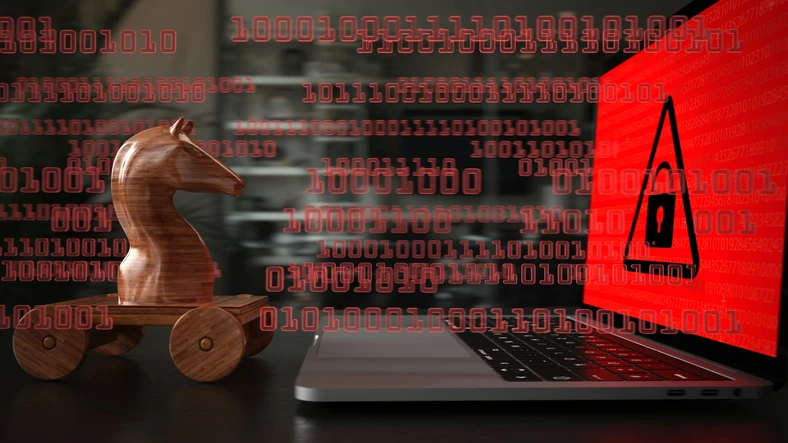Common Types of Trojan Horses
Trojan Horses are a versatile and dangerous form of malware that come in many shapes and sizes, each designed to exploit specific vulnerabilities in a system. Understanding the common types of Trojan Horses can help individuals and organizations recognize and defend against these threats effectively. Here are some of the most prevalent types:
- Remote Access Trojans (RATs)
Remote Access Trojans are among the most dangerous types of Trojan Horses. They allow attackers to gain complete control over an infected device remotely. Once installed, RATs can perform actions such as stealing sensitive data, activating webcams, logging keystrokes, and even installing additional malware. These Trojans are often distributed through phishing emails or malicious downloads. - Banking Trojans
Banking Trojans are specifically designed to target financial information. They aim to steal banking credentials, credit card details, and other sensitive financial data. These Trojans often mimic legitimate banking apps or websites, tricking users into entering their information. Popular examples include Zeus and Dridex, which have caused significant financial losses worldwide. - Downloader Trojans
Downloader Trojans are not harmful by themselves but serve as a gateway for more malicious payloads. Once installed, they download and execute other forms of malware, such as ransomware, spyware, or additional Trojans. These are commonly used in multi-stage attacks to infiltrate a system stealthily. - Spyware Trojans
As the name suggests, spyware Trojans are designed to spy on users. They monitor user activity, track browsing behavior, and collect sensitive information such as login credentials or personal data. This information is then sent back to the attacker. Spyware Trojans are often bundled with free software downloads or distributed via malicious websites. - Backdoor Trojans
Backdoor Trojans create a hidden entry point into an infected device, allowing attackers to bypass security measures and gain unauthorized access. Once a backdoor is established, attackers can use it to control the system, steal data, or even form a botnet for larger-scale attacks. - Trojan-Droppers
These Trojans are designed to bypass antivirus programs by "dropping" malware onto the system. They often evade detection by encrypting or hiding their malicious payload until the system is compromised. Trojan-Droppers are typically used in advanced, persistent threats. - Rootkit Trojans
Rootkits are used to conceal other malware on a system, making it difficult to detect and remove infections. A Rootkit Trojan can hide files, processes, or registry entries related to the malware, ensuring the malicious activity remains undetected for long periods. - Fake Antivirus Trojans
Fake antivirus Trojans trick users into believing their system is infected with viruses. They prompt users to purchase or install fake security software, which is actually malware. These scams often lead to financial loss and further system compromise. - Ransomware Trojans
Some Trojan Horses serve as a delivery mechanism for ransomware. Once executed, the ransomware encrypts the user’s files and demands payment for their decryption. This type of attack is particularly devastating for businesses and individuals who rely heavily on their data.
The Dangers of Trojan Horse Malware
Trojan Horse malware is one of the most deceptive and damaging types of cyber threats. By disguising itself as legitimate software, it infiltrates systems and causes harm in a variety of ways, often without the user realizing until it’s too late. Here are the most significant dangers posed by Trojan Horse malware:
- Data Theft
One of the primary goals of many Trojan Horses is to steal sensitive data. This includes login credentials, financial information, personal identification, and business-critical documents. For example, banking Trojans target online banking platforms to capture usernames, passwords, and credit card numbers, leading to significant financial losses. - System Compromise
Trojan Horses often provide attackers with remote access to infected systems. Through tools like Remote Access Trojans (RATs),cybercriminals can take control of a device, execute commands, install additional malware, and monitor user activity. This level of control allows attackers to exploit the system for their own gain while the user remains unaware. - Financial Loss
Trojan Horses can result in direct and indirect financial losses. Fake antivirus Trojans, for instance, trick users into purchasing counterfeit security software, only to install more malware. Banking Trojans, on the other hand, directly siphon funds from victims’ accounts. The cleanup and recovery process from a Trojan infection can also incur significant costs for businesses and individuals. - Spreading Additional Malware
Trojan Horses often act as a gateway for other types of malware. Downloader Trojans, for instance, are designed to download and install ransomware, spyware, or even other Trojan Horses. This cascading effect amplifies the damage, making the initial infection only the beginning of a larger attack. - Network Vulnerabilities
When a Trojan Horse infects a system, it can create vulnerabilities across an entire network. For example, a backdoor Trojan may provide attackers with hidden access points into a corporate network, allowing them to exfiltrate data, spread malware, or launch further attacks, such as distributed denial-of-service (DDoS) campaigns. - Loss of Privacy
Spyware Trojans are particularly dangerous because they compromise user privacy. These Trojans monitor online activity, track keystrokes, and even activate webcams or microphones without the user’s consent. This invasion of privacy can lead to identity theft, blackmail, or other forms of exploitation. - Disruption of Operations
For businesses, Trojan Horses can disrupt operations significantly. Ransomware Trojans, which often encrypt critical files, can bring productivity to a halt. Recovery from such incidents can take days or weeks, leading to financial losses and reputational damage. - Hard-to-Detect Persistence
Many Trojan Horses are designed to evade detection and remain active for extended periods. Rootkit Trojans, for instance, hide malicious activities from antivirus programs, making them difficult to remove. This persistence allows attackers to carry out long-term exploits, such as stealing data over months or years. - Creation of Botnets
Some Trojan Horses turn infected devices into part of a botnet, a network of compromised systems controlled by an attacker. Botnets are commonly used for launching DDoS attacks, sending spam emails, or mining cryptocurrency without the user’s consent. This not only exploits the victim’s resources but can also implicate them in illegal activities. - Reputational Damage
For businesses, a Trojan Horse infection can lead to significant reputational damage. If customer data is stolen or operations are disrupted, the organization may lose the trust of its clients and partners. This can have long-lasting effects on revenue and growth.
Best Practices for Preventing Trojan Horse Attacks
Preventing Trojan Horse attacks requires a combination of robust cybersecurity practices, user awareness, and advanced tools to detect and block potential threats. Below are the best practices to protect your systems and data from Trojan Horse malware.
- Install Reliable Antivirus and Anti-Malware Software
Using trusted antivirus and anti-malware programs is one of the first lines of defense against Trojan Horses. These tools can detect and remove malicious files before they cause harm. Regularly update your security software to ensure it has the latest virus definitions and can detect emerging threats. - Keep Your Operating System and Software Updated
Outdated systems and software often contain vulnerabilities that attackers can exploit. Regular updates and patches address these security gaps, making it harder for Trojan Horses to gain access. Enable automatic updates whenever possible to stay protected without manual intervention. - Avoid Opening Suspicious Emails and Attachments
Phishing emails are a common delivery method for Trojan Horses. Be cautious of emails from unknown senders or those with urgent, unsolicited requests. Avoid clicking on links or downloading attachments unless you are confident of their legitimacy. - Use Strong, Unique Passwords
Weak or reused passwords make it easier for attackers to compromise your accounts. Use complex, unique passwords for each account and consider using a password manager to securely store them. Enable two-factor authentication (2FA) wherever possible to add an extra layer of security. - Download Software from Trusted Sources
Trojan Horses often disguise themselves as legitimate software available on unverified websites. Always download programs from official vendor websites or reputable app stores. Avoid pirated or cracked software, as these are common carriers of malware. - Implement Firewalls
Firewalls act as a barrier between your network and potential threats. They monitor and control incoming and outgoing traffic, blocking unauthorized access to your system. Ensure your firewall is active and properly configured for maximum protection. - Educate Yourself and Your Team
User awareness is crucial in preventing Trojan Horse attacks. Regularly educate yourself and your team on recognizing phishing attempts, suspicious links, and other common attack methods. Cybersecurity training can significantly reduce the risk of accidental infections. - Be Wary of Pop-Ups and Fake Alerts
Trojan Horses often use fake pop-ups and alerts to trick users into downloading malware. For example, a fake antivirus alert might prompt you to "fix" a non-existent issue. Always verify alerts and avoid clicking on anything suspicious. - Regularly Back Up Your Data
In case a Trojan Horse manages to bypass your defenses, having a recent backup can minimize the damage. Use a secure, offline location for backups to prevent malware from infecting or encrypting them. Test your backups periodically to ensure they can be restored. - Monitor Network Activity
Unusual network activity can indicate the presence of a Trojan Horse. Use network monitoring tools to detect unauthorized data transfers, unusual traffic patterns, or other anomalies that could signal an infection. - Enable Email Filtering
Email filtering tools can block spam and phishing emails that often carry Trojan Horses. Set up filters to identify and quarantine suspicious emails before they reach your inbox. This reduces the chances of accidental clicks on malicious links or attachments. - Use Application Whitelisting
Application whitelisting allows only pre-approved applications to run on your system, blocking unauthorized programs, including Trojan Horses. This practice is especially effective for businesses and organizations managing multiple devices. - Disable Macros in Office Documents
Macros are often used to execute malicious code embedded in documents. Unless you specifically need them, disable macros in Microsoft Office and other software to reduce the risk of Trojan Horse infections. - Regularly Audit Security Measures
Conduct regular security audits to identify and fix vulnerabilities in your systems. This proactive approach ensures that your defenses are always up to date and capable of preventing Trojan Horse attacks.
- What is Malware Detection?
- Malware vs. Viruses: Understanding the Key Differences
- What is Endpoint Protection?
- What is the Cyberattack Kill Chain (CKC)?
- What is a Botnet?
- What is a Polymorphic Virus?
- What is Bootkit?
- What are Indicators of Compromise (IOCs)?
- What are Brute Force Attacks?
- Endpoint Protection Platform (EPP) vs Endpoint Detection and Response (EDR)






